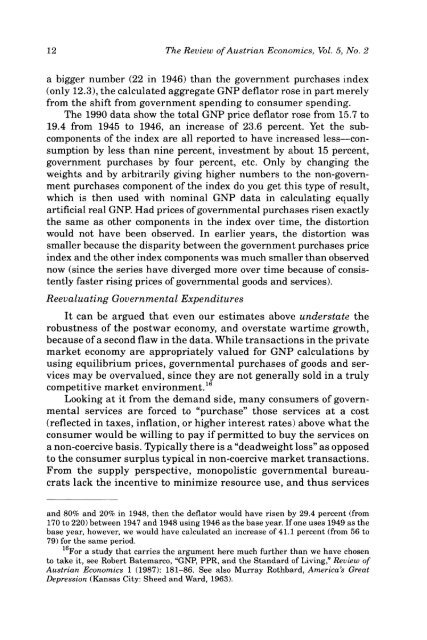Review of Austrian Economics - The Ludwig von Mises Institute
Review of Austrian Economics - The Ludwig von Mises Institute
Review of Austrian Economics - The Ludwig von Mises Institute
Create successful ePaper yourself
Turn your PDF publications into a flip-book with our unique Google optimized e-Paper software.
12 <strong>The</strong> <strong>Review</strong> <strong>of</strong> <strong>Austrian</strong> <strong>Economics</strong>, Vol. 5, No. 2<br />
a bigger number (22 in 1946) than the government purchases index<br />
(only 12.3), the calculated aggregate GNP deflator rose in part merely<br />
from the shift from government spending to consumer spending.<br />
<strong>The</strong> 1990 data show the total GNP price deflator rose from 15.7 to<br />
19.4 from 1945 to 1946, an increase <strong>of</strong> 23.6 percent. Yet the subcomponents<br />
<strong>of</strong> the index are all reported to have increased less—consumption<br />
by less than nine percent, investment by about 15 percent,<br />
government purchases by four percent, etc. Only by changing the<br />
weights and by arbitrarily giving higher numbers to the non-government<br />
purchases component <strong>of</strong> the index do you get this type <strong>of</strong> result,<br />
which is then used with nominal GNP data in calculating equally<br />
artificial real GNP. Had prices <strong>of</strong> governmental purchases risen exactly<br />
the same as other components in the index over time, the distortion<br />
would not have been observed. In earlier years, the distortion was<br />
smaller because the disparity between the government purchases price<br />
index and the other index components was much smaller than observed<br />
now (since the series have diverged more over time because <strong>of</strong> consistently<br />
faster rising prices <strong>of</strong> governmental goods and services).<br />
Reevaluating Governmental Expenditures<br />
It can be argued that even our estimates above understate the<br />
robustness <strong>of</strong> the postwar economy, and overstate wartime growth,<br />
because <strong>of</strong> a second flaw in the data. While transactions in the private<br />
market economy are appropriately valued for GNP calculations by<br />
using equilibrium prices, governmental purchases <strong>of</strong> goods and services<br />
may be overvalued, since they are not generally sold in a truly<br />
competitive market environment. 16<br />
Looking at it from the demand side, many consumers <strong>of</strong> governmental<br />
services are forced to "purchase" those services at a cost<br />
(reflected in taxes, inflation, or higher interest rates) above what the<br />
consumer would be willing to pay if permitted to buy the services on<br />
a non-coercive basis. Typically there is a "deadweight loss" as opposed<br />
to the consumer surplus typical in non-coercive market transactions.<br />
From the supply perspective, monopolistic governmental bureaucrats<br />
lack the incentive to minimize resource use, and thus services<br />
and 80% and 20% in 1948, then the deflator would have risen by 29.4 percent (from<br />
170 to 220) between 1947 and 1948 using 1946 as the base year. If one uses 1949 as the<br />
base year, however, we would have calculated an increase <strong>of</strong> 41.1 percent (from 56 to<br />
79) for the same period.<br />
16 For a study that carries the argument here much further than we have chosen<br />
to take it, see Robert Batemarco, "GNP, PPR, and the Standard <strong>of</strong> Living," <strong>Review</strong> <strong>of</strong><br />
<strong>Austrian</strong> <strong>Economics</strong> 1 (1987): 181-86. See also Murray Rothbard, America's Great<br />
Depression (Kansas City: Sheed and Ward, 1963).

















